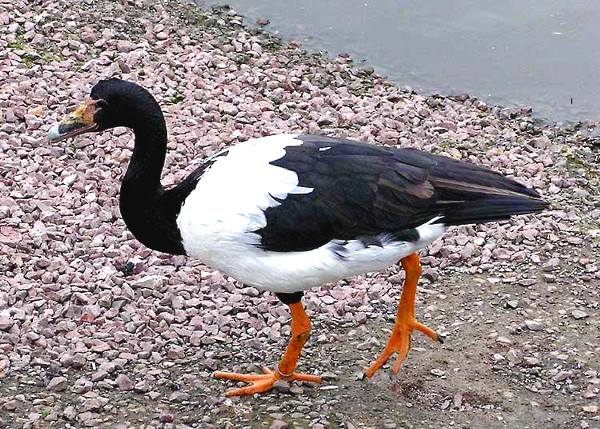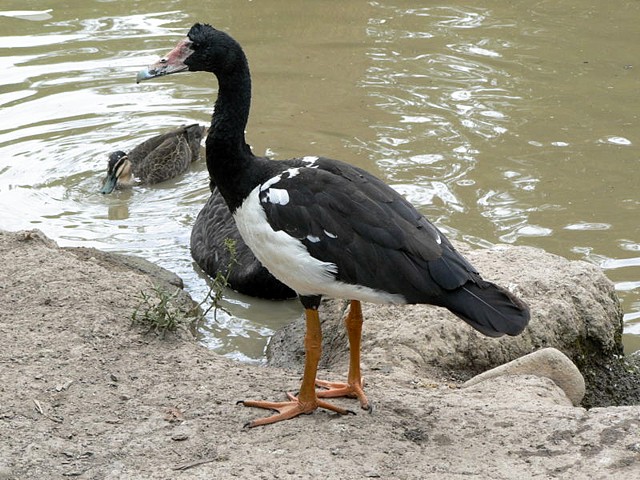Lessico
Oca gazza
Oca semipalmata
Anseranas semipalmata

La prima sottofamiglia degli Anatidi, gli Anseranatini, comprende un solo genere e un'unica specie, l'Oca gazza (credo per il colore del piumaggio) o Oca semipalmata, Anseranas semipalmata, il cui nome latino tradotto letteralmente significa oca-anatra, essendo in realtà né un'oca né un'anatra. In inglese è detta Magpie-goose = Gazza oca.
Non
si sa ancora con sicurezza se essa sia una forma molto antica e primitiva
degli Anserini o debba essere piuttosto considerata una forma di collegamento
fra questi e gli Animidi![]() .
.
Il
nome semipalmata dato alla specie si riferisce a una delle sue caratteristiche
più vistose, e cioè al fatto che le membrane natatorie sono alquanto ridotte
e collegano in pratica la sola radice delle dita. Altra peculiarità è il
dito posteriore – o alluce – molto lungo e inserito allo stesso livello
degli altri: insomma, è un peristeropode![]() ,
per cui il piede somiglia a quello del piccione, che in greco è detto peristerà.
,
per cui il piede somiglia a quello del piccione, che in greco è detto peristerà.
Questo uccello dal monomorfismo e monocromatismo sessuale abita esclusivamente i territori paludosi della Nuova Guinea meridionale, dell'Australia settentrionale, orientale e meridionale e della Tasmania. Vivono in gruppi e stanno di preferenza sugli alberi. Ecco perché non hanno mai desiderato, oppure si sono liberati della membrana interdigitale!
www.bsc-eoc.org/avibase/

Scientific classification
Kingdom: Animalia
Phylum: Chordata
Class: Aves
Order: Anseriformes
Family: Anseranatidae Sclater, 1880
Genus: Anseranas Lesson, 1828
Species: Anseranas semipalmata
Binomial name Anseranas semipalmata Latham, 1798
The Magpie-goose, Anseranas semipalmata is an unusual member of the bird order Anseriformes, the latter containing about 150 living species in three families.
The Magpie-goose is a resident breeder in northern Australia, (where it is not threatened and has a controlled hunting season when numbers are large), and southern New Guinea. It is found in a variety of open wet areas such as floodplains and swamps. It is fairly sedentary apart from some movement during the dry season.
Its nest is on the ground, and a typical clutch is 5-14 eggs. Some males mate with two females.
Magpie-geese are unmistakable birds with their black and white plumage and yellowish legs. The feet are only partially webbed, although the Magpie-goose will feed on vegetable matter in the water as well as on land. Males are larger than females. Unlike true geese, the moult is gradual, and there is no flightless period.
They are colonial breeders and are gregarious outside of the breeding season when they can form large and noisy flocks of up to a few thousand individuals. The voice is a loud honking.
This species is distinctive enough to be the sole member of the Anseranatidae; the other two living families are the Anhimidae, the screamers, and the Anatidae, the ducks, geese, and swans. The Magpie-goose is the only member of its genus Anseranas.
This family is quite old, having apparently diverged before the Cretaceous–Tertiary extinction event. The fossil record is limited, nonetheless, with an undescribed species from the Late Oligocene of Billy-Créchy (France) being known (Hugueney et al, 2003). The enigmatic genus Anatalavis (Hornerstown Late Cretaceous/Early Paleocene of New Jersey, USA - London Clay Early Eocene of Walton-on-the-Naze, England) is sometimes considered to be the earliest known anseranatid.
Conservation Status - State of Victoria, Australia - The Magpie Goose is listed as threatened on the Victorian Flora and Fauna Guarantee Act 1988. Under this Act, an Action Statement for the recovery and future management of this species has not been prepared.On the 2007 advisory list of threatened vertebrate fauna in Victoria, this species is listed as near threatened.